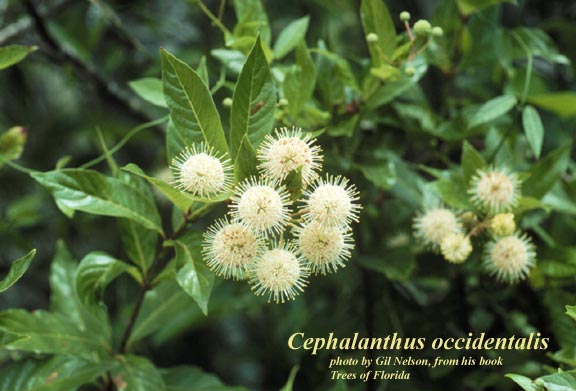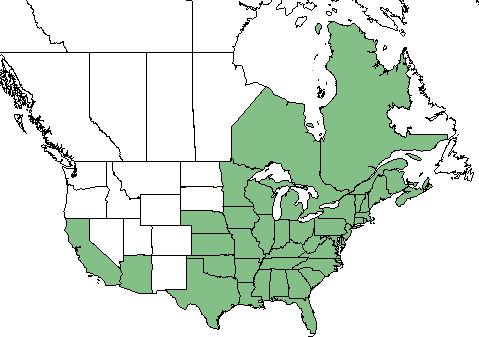Difference between revisions of "Cephalanthus occidentalis"
(→Taxonomic Notes) |
(→Description) |
||
| Line 24: | Line 24: | ||
==Description== | ==Description== | ||
| − | ''C. occidentalis'' is a perennial shrub/tree of the Rubiaceae family native to North America. <ref name= "USDA"> [https://plants.usda.gov/core/profile?symbol=CEAM USDA Plant Database]</ref> | + | ''C. occidentalis'' is a perennial shrub/tree of the Rubiaceae family native to North America.<ref name= "USDA"> [https://plants.usda.gov/core/profile?symbol=CEAM USDA Plant Database]</ref> |
| − | <!-- Basic life history facts such as annual/perrenial, monoecious/dioecious, root morphology, seed type, etc. --> | + | <!-- Basic life history facts such as annual/perrenial, monoecious/dioecious, root morphology, seed type, etc. --> It contains the poison cephalathin, which induces vomiting, convulsions, and paralysis if ingested. This shrub reaches heights of 6 meters, is multi-stemmed, and stem bases are swollen. Twigs are green when young, have elongated lenticels, 4-sided, and brown and scaly when mature. Leaves whorled or oppositely arranged, glossy in appearance and dark green, developing in May. Flowers tube-shaped, 4 or 5-lobed, reddish to white in color, and develop in dense clusters at branch ends; the long styles on the flower give the pincushion like appearance. Fruit ball-shaped with 2-seeded nutlets enclosed. It can easily be identified by the flower heads, elongated lenticels, or swollen stem bases.<ref name= "Wennerberg">Wennerberg, S. (2006). Plant Guide: Common Buttonbush ''Cephalanthus occidentalis''. N.R.C.S. United States Department of Agriculture. Baton Rouge, LA.</ref> |
==Distribution== | ==Distribution== | ||
Revision as of 15:58, 4 April 2019
Common Names: Common Buttonbush [1], Globeflower [2]
| Cephalanthus occidentalis | |
|---|---|

| |
| Photo by the Atlas of Florida Plants Database | |
| Scientific classification | |
| Kingdom: | Plantae |
| Division: | Magnoliophyta - Flowering plants |
| Class: | Magnoliopsida - Dicots |
| Order: | Rubiales |
| Family: | Rubiaceae |
| Genus: | Cephalanthus |
| Species: | C. occidentalis |
| Binomial name | |
| Cephalanthus occidentalis L. | |

| |
| Natural range of Cephalanthus occidentalis from USDA NRCS Plants Database. | |
Contents
Taxonomic Notes
Synonyms: Cephalanthus occidentalis L. var. occidentalis, Cephalanthus occidentalis L. var. pubescens Raf.
Varieties: none
Description
C. occidentalis is a perennial shrub/tree of the Rubiaceae family native to North America.[1]
It contains the poison cephalathin, which induces vomiting, convulsions, and paralysis if ingested. This shrub reaches heights of 6 meters, is multi-stemmed, and stem bases are swollen. Twigs are green when young, have elongated lenticels, 4-sided, and brown and scaly when mature. Leaves whorled or oppositely arranged, glossy in appearance and dark green, developing in May. Flowers tube-shaped, 4 or 5-lobed, reddish to white in color, and develop in dense clusters at branch ends; the long styles on the flower give the pincushion like appearance. Fruit ball-shaped with 2-seeded nutlets enclosed. It can easily be identified by the flower heads, elongated lenticels, or swollen stem bases.[3]
Distribution
The C. occidentalis is found in the eastern United States, California and Arizona, as well as eastern Canada. [1]
Ecology
Habitat
C. occidentalis habitat is primarily wetlands. It can be found on streambanks, depressional wetlands, lakes, and in other standing water. [4]
This shrub requires full sunlight for flowering and can withstand habitats of up to three feet of standing water. [1]
Seed bank and germination
Seeds of the C. occidentalis need to be germinated in moist soil under full sun or slight shade. [1]
Use by animals
The seeds of the C. occidentalis shrub is eaten by waterfowl and wood ducks will use the structure of the shrub for nesting. Also, bees and other insects use the pollen and nectar. [1]
Conservation and Management
Herbicides can be detrimental to the species. Intense fires will decrease the response of regrowth, though the C.. occidentalis can resprout after lower intensity burns. [1]
Cultivation and restoration
C. occidentalis can be used for erosion control on shorelines. It has a strong base that can stabilize the plant and the shoreline. [1]
Photo Gallery
References and notes
- ↑ 1.0 1.1 1.2 1.3 1.4 1.5 1.6 1.7 USDA Plant Database
- ↑ Gee, K. L., et al. (1994). White-tailed deer: their foods and management in the cross timbers. Ardmore, OK, Samuel Roberts Noble Foundation.
- ↑ Wennerberg, S. (2006). Plant Guide: Common Buttonbush Cephalanthus occidentalis. N.R.C.S. United States Department of Agriculture. Baton Rouge, LA.
- ↑ Weakley, A. S. (2015). Flora of the Southern and Mid-Atlantic States. Chapel Hill, NC, University of North Carolina Herbarium.